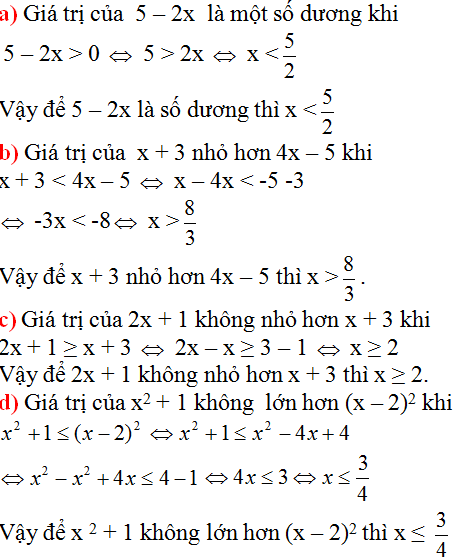Hãy nhập câu hỏi của bạn vào đây, nếu là tài khoản VIP, bạn sẽ được ưu tiên trả lời.

\(1,a,A=x^2-6x+25\)
\(=x^2-2.x.3+9-9+25\)
\(=\left(x-3\right)^2+16\)
Ta có :
\(\left(x-3\right)^2\ge0\)Với mọi x
\(\Rightarrow\left(x-3\right)^2+16\ge16\)
Hay \(A\ge16\)
\(\Rightarrow A_{min}=16\)
\(\Leftrightarrow x=3\)

\(A=\frac{x^2-2x+2011}{x^2}=\frac{x^2}{x^2}-\frac{2x}{x^2}+\frac{2011}{x^2}=1-\frac{2}{x}+\frac{2011}{x^2}\)
Đặt \(t=\frac{1}{x}\) ta có: \(A=2011t^2-2t+1\)
\(\Leftrightarrow A=2011t^2-2t+\frac{1}{2011}+\frac{2010}{2011}\)
\(\Leftrightarrow A=2011\left(t^2-\frac{2t}{2011}+\frac{1}{2011^2}\right)+\frac{2010}{2011}\)
\(\Leftrightarrow A=2011\left(t-\frac{1}{2011}\right)^2+\frac{2010}{2011}\ge\frac{2010}{2011}\)
Đẳng thức xảy ra khi \(t=\frac{1}{2011}\Leftrightarrow x=2011\)
Ta có:\(\frac{x^2-2x+2011}{x^2}\ge\frac{2010}{2011}\Rightarrow2011\left(x^2-2x+2011\right)\ge2010x^2\)
\(\Rightarrow2011x^2-2x2011+2011^2\ge2010^2\)
\(\Rightarrow2011x^2-2x2011+2011-2010x^2\ge0\)
\(\Rightarrow x^2-2x2011+2011^2\ge0\)
\(\Rightarrow\left(x-2011\right)^2\ge0\)(đúng)
\(\Rightarrow\)đpcm

\(A=\dfrac{1}{-x^2+2x-2}\)
A min \(\Leftrightarrow\dfrac{1}{A}\)max
ta có \(\dfrac{1}{A}=-x^2+2x-2=-\left(x^2-2x+2\right)=-\left(x-1\right)^2-1\le-1\)
\(\dfrac{1}{A}\)max= -1 tại x=1
=> A min = -1 tại x=1
\(B=\dfrac{2}{-4x^2+8x-5}\) ( phải là -4x2 nha bn)
B min \(\Leftrightarrow\dfrac{1}{B}\) max
ta có \(\dfrac{1}{B}=\dfrac{-4x^2+8x-5}{2}=\dfrac{-\left(4x^2-8x+5\right)}{2}=\dfrac{-\left(2x-4\right)^2+11}{2}=\dfrac{\left(-2x-4\right)^2}{2}+\dfrac{11}{2}\le\dfrac{11}{2}\)
\(\dfrac{1}{B}\)max=\(\dfrac{11}{2}\) tại x=2
\(\Rightarrow B\) min = \(\dfrac{1}{\dfrac{11}{2}}=\dfrac{2}{11}\) tại x=2
\(A=\dfrac{3}{2x^2+2x+3}=\dfrac{3}{2\left(x^2+2.x.\dfrac{1}{2}+\dfrac{1}{4}\right)+\dfrac{5}{2}}=\dfrac{3}{2\left(x+\dfrac{1}{2}\right)^2+\dfrac{5}{2}}\)
A max \(\Leftrightarrow\dfrac{1}{A}\) min
\(\Leftrightarrow\dfrac{2\left(x+\dfrac{1}{2}\right)^2+\dfrac{5}{2}}{3}=\dfrac{2\left(x+\dfrac{1}{2}\right)^2}{3}+\dfrac{\dfrac{5}{2}}{3}=\dfrac{2\left(x+\dfrac{1}{2}\right)^2}{3}+\dfrac{5}{6}\ge\dfrac{5}{6}\)
\(\dfrac{1}{A}\) min = \(\dfrac{5}{6}\)tại x= \(-\dfrac{1}{2}\)
\(\Rightarrow A\)max = \(\dfrac{6}{5}\) tại x= \(-\dfrac{1}{2}\)
B\(=\dfrac{5}{3x^2+4x+15}=\dfrac{5}{3.\left(x^2+\dfrac{4}{3}x+5\right)}=\dfrac{5}{3\left(x^2+2.x.\dfrac{2}{3}+\dfrac{4}{9}+\dfrac{41}{9}\right)}=\dfrac{5}{3\left(x+\dfrac{2}{3}\right)^2+\dfrac{41}{3}}\)
B max \(\Leftrightarrow\dfrac{1}{B}\) min
\(\Leftrightarrow\dfrac{3\left(x+\dfrac{2}{3}\right)^2+\dfrac{41}{3}}{5}=\dfrac{3\left(x+\dfrac{2}{3}\right)^2}{5}+\dfrac{41}{15}\ge\dfrac{41}{15}\)
\(\dfrac{1}{B}\) min = \(\dfrac{41}{15}\) tại x=\(-\dfrac{2}{3}\)
=> \(B\) max = \(\dfrac{15}{41}\) tại x=\(-\dfrac{2}{3}\)
Đây chỉ là gợi ý !! bn pải tự lí luận nha
tik ![]()

\(A=2x^2+y^2-2xy-2x+3\)
\(A=\left(x^2-2xy+y^2\right)+\left(x^2-2x+1\right)+2\)
\(A=\left(x-y\right)^2+\left(x-1\right)^2+2\)
Mà \(\left(x-y\right)^2\ge0\forall x;y\)
\(\left(x-1\right)^2\ge0\forall x\)
\(\Rightarrow A\ge2\)
Dấu "=" xảy ra khi :
\(\hept{\begin{cases}x-y=0\\x-1=0\end{cases}}\Leftrightarrow\hept{\begin{cases}y=1\\x=1\end{cases}}\)
Vậy Min A = 2 khi x=y=1

Tuy mk không biết làm nhưng mình sẽ đánh dấu bài này mk không cần bạn k nhưng bạn k trong các câu khác nha.
Chưa có ai trả lời câu hỏi này, hãy gửi một câu trả lời để giúp Trang Nhung giải bài toán này.

A=x4+12+2x3+2x+3x2
A=(x2)2+2(x2)(1)+(1)2-2x2+2x(x2+1)+3x2
A=(x2+1)2+2x(x2+1)+x2
Đặt a=x2+1
Khi đó đa thức trở thành:
A=a2+2ax+x2
A=(a+x)2
A=(x2+1+x)2
\(A=\left(x\right)^2+2\left(x\right)\left(\frac{1}{2}\right)+\left(\frac{1}{2}\right)^2-\frac{1}{4}+\frac{4}{4}\)
\(A=\left[\left(x+\frac{1}{2}\right)^2+\frac{3}{4}\right]^2\)
Ta có:
\(\left(x+\frac{1}{2}\right)^2\ge0\forall x\)
\(\Leftrightarrow\left(x+\frac{1}{2}\right)^2+\frac{3}{4}\ge\frac{3}{4}\)
\(\Leftrightarrow A\ge\frac{3}{4}\)
Dấu"=" xảy ra khi:
\(x+\frac{1}{2}=0\)
\(\Leftrightarrow x=\frac{-1}{2}\)
Vậy GTNN của A là \(\frac{3}{4}\)khi x=\(\frac{-1}{2}\)
hình như theo cách giải của Nguyễn Triệu Khả Nhi thì GTNN của P=0 thì mới đúng

a) Để giá trị biểu thức 5 – 2x là số dương
<=> 5 – 2x > 0
<=> -2x > -5 ( Chuyển vế và đổi dấu hạng tử 5 )
\(\Leftrightarrow x< \frac{5}{2}\)( Chia cả 2 vế cho -2 < 0 ; BPT đổi chiều )
Vậy : \(x< \frac{5}{2}\)
b) Để giá trị của biểu thức x + 3 nhỏ hơn giá trị biểu thức 4x - 5 thì:
x + 3 < 4x – 5
<=< x – 4x < -3 – 5 ( chuyển vế và đổi dấu các hạng tử 4x và 3 )
<=> -3x < -8
\(\Leftrightarrow x>\frac{8}{3}\)( Chia cả hai vế cho -3 < 0, BPT đổi chiều).
Vậy : \(x>\frac{8}{3}\)
c) Để giá trị của biểu thức 2x +1 không nhỏ hơn giá trị của biểu thức x + 3 thì:
2x + 1 ≥ x + 3
<=> 2x – x ≥ 3 – 1 (chuyển vế và đổi dấu các hạng tử 1 và x).
<=> x ≥ 2.
Vậy x ≥ 2.
d) Để giá trị của biểu thức x2 + 1 không lớn hơn giá trị của biểu thức (x - 2)2 thì:
x2 + 1 ≤ (x – 2)2
<=> x2 + 1 ≤ x2 – 4x + 4
<=> x2 – x2 + 4x ≤ 4 – 1 ( chuyển vế và đổi dấu hạng tử 1; x2 và – 4x).
<=> 4x ≤ 3
\(\Leftrightarrow x\le\frac{3}{4}\)( Chia cả 2 vế cho 4 > 0 )
Vậy : \(x\le\frac{3}{4}\)

\(A=2x^2+2\sqrt{2}x+3\\ =2\left(x^2+\sqrt{2}x+\dfrac{3}{2}\right)\\ =2.\left(x^2+2.\dfrac{1}{\sqrt{2}}x+\dfrac{1}{2}+1\right)\\ =2.\left(x^2+2.\dfrac{1}{\sqrt{2}}x+\dfrac{1}{2}\right)+2\\ =2.\left(x+\dfrac{1}{\sqrt{2}}\right)^2+2\)
Ta có \(2.\left(x+\dfrac{1}{\sqrt{2}}\right)^2\ge0\forall x\)
\(2.\left(x+\dfrac{1}{\sqrt{2}}\right)^2+2\ge2\forall x\)
Dấu bằng xảy ra khi : \(x+\dfrac{1}{\sqrt{2}}=0\\ \Rightarrow x=\dfrac{-\sqrt{2}}{2}\)
Vậy \(Min_A=2\) khi \(x=\dfrac{-\sqrt{2}}{2}\)